|
|
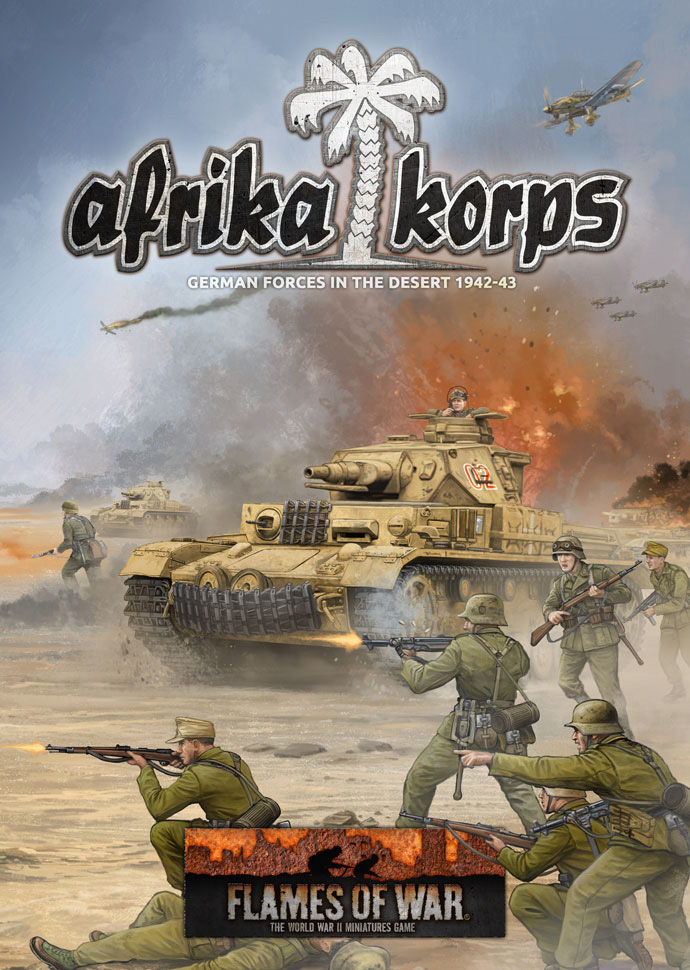 |
A Brief History of the Deutsches Afrikakorps
SONNENBLUME
In February 1941 Hitler summoned Rommel. The Italians had been defeated by the British in North Africa, losing Libya, and needed help. Rommel was given command of the Deutsches Afrikakorps (DAK), the German Africa Corps. The name was a play on Deutsches Alpenkorps, the German Alpine Corps that Rommel had served in when he defeated the Italians 24 years earlier.
The Deutsches Afrikakorps was initially just the 5th Light Division, but was doubled when 15 Panzer a full panzer division arrived. Rommel arrived in Tripoli on February 12, 1941. "Something had to be done to bring the British offensive to a halt," he wrote. By now the British had moved as far as El Ageila, 400 miles from Tripoli.
|
|
The force, consisting of 15. Panzerdivision and 5. leichte Division, was placed under Italian command, with orders to stay on the defence at El Agheila. But Rommel characteristically disregarded his orders, and launched an attack under the codename Sonnenblume, routing British forces from Libya in a whirlwind advance.
His tactical cunning quickly earned him the nickname ‘the Desert Fox’.
|
|
TOBRUK
The speed of the advance was such that the 9th Australian Division was cut off and surrounded in the Libyan port of Tobruk. In a series of seesaw battles on the Egyptian border (Operations Brevity, Skorpion, Battleaxe, and Sommernachtstraum) the British and Germans attacked in turns.
The British attacks to relieve Tobruk in May and June 1941 foundered on the dug-in 8.8cm guns of the Afrikakorps, while the German attacks only served to consolidate their hold on the frontier. Exhausted both sides prepared for the next round.
|
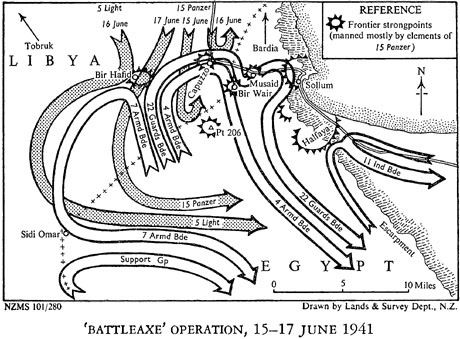 |
|
Rommel’s Afrikakorps received fresh tanks and anti-tank guns, allowing 5. leichte Division to be strengthened and re-titled 21. Panzerdivision and various independent units to be organised into a new Division Afrika zbV (soon renamed 90. leichte Afrikadivision).
These prepared for a renewed assault on Tobruk. On the other side of the frontier, the British were reinforced and reorganised, their forces being renamed the Eighth Army.
|
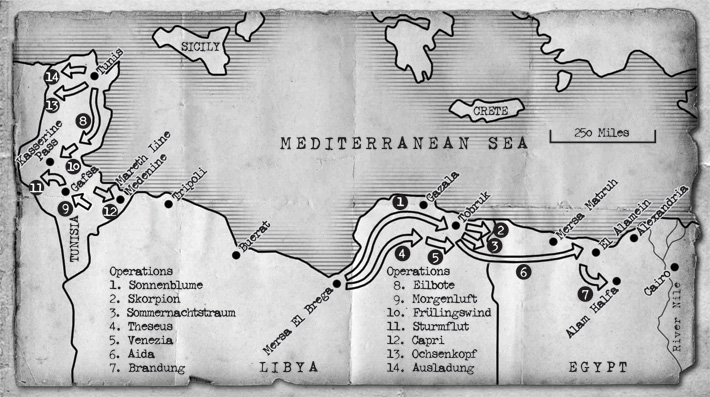 |
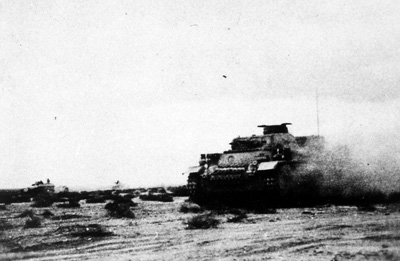 |
TOTENSONTAG
On 19 November 1941, just days before Rommel’s planned attack on Tobruk, the Eighth Army launched a surprise offensive codenamed Crusader. A confusing series of tank battles took place east of Tobruk with Rommel often taking direct command of units to stop British attacks. On 23 November—Totensonntag, the holy Sunday of the Dead—the Afrikakorps and their Italian allies scattered the remnants of the British armour.
The Desert Fox now made a rash decision. He ordered his two Panzer divisions to race to the Egyptian frontier, to cut off what he thought were the beaten remnants of the British army.
|
|
It was a big mistake. The Eighth Army was still fighting on. Rommel’s ‘race to the wire’ wore down his Panzers on a fruitless chase across the Libyan desert before returning to the Tobruk front, where fighting continued to rage. The Afrikakorps was now very weak while the British were getting more reinforcements daily. Reluctantly, Rommel ordered the retreat back to Gazala, and then El Agheila.
Once again the British supply line was stretched thin while Rommel received reinforcements. Ignoring his Italian allies, the Desert Fox struck out in January 1942 with Operation Theseus. The inexperienced British 1st Armoured Division was caught by surprise and routed back to Gazala.
|
VENEZIA
On 26 May 1942 Rommel once again beat the British to the punch and commenced Operation Venezia to take Tobruk. In a daring manoeuvre the Afrikakorps swung south behind the fortified British line at Gazala.
Uncoordinated but stubborn resistance by the British armoured regiments brought the Afrikakorps to a halt, trapped behind the British line, out of fuel and water, and outnumbered. In his classic style, the Desert Fox appeared wherever the fighting was most desperate to inspire and take control. |
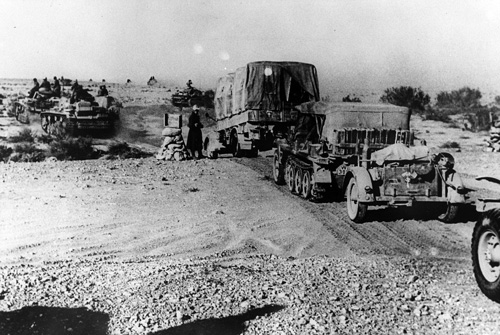 |
| Rommel broke back through the British line to re-open his supply lines. Driving his men on, Rommel’s forces then turned and routed the Eighth Army before storming Tobruk on 20 June, completing his greatest victory and taking 60,000 prisoners along with vast quantities of supplies. Complete victory in the Middle East beckoned. |
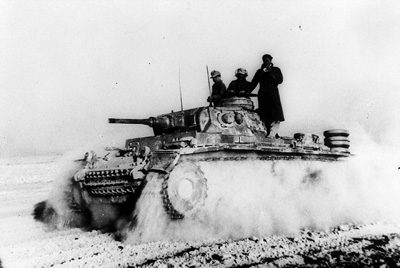 |
‘ON TO CAIRO!’
Launching Operation Aida, Rommel pursued the fleeing British who turned to fight at El Alamein, barely 60 miles from the River Nile. The Afrikakorps, severely weakened by weeks of constant combat and thousands of miles of wear and tear across the harsh desert, constantly harried by the Royal Air Force, could not break through the hasty British line. All of Rommel’s energy and improvisation could not overcome the lack of fuel and exhaustion of his men. The daring offensive petered out.
Once again, both sides reinforced and, once again, it was Rommel who struck first.
|
|
In late August the Desert Fox launched Operation Brandung and broke through the British line. But the new British commander, General Montgomery, was ready and repelled Rommel’s attack at Alam Halfa ridge.
Rommel’s troops were outnumbered and low on supplies. They fell back to their starting position and dug deep minefields and waited for the inevitable British attack. Rommel, ill after 18 months in the desert, returned to Germany for a much needed rest.
|
EL ALAMEIN
On 23 October the British launched a massive offensive. Rommel quickly flew back to the front to take charge.
The situation was dire. Rommel was outnumbered and British troops were already through the minefields and slowly chewing up his main defensive line. The fighting was hard. Counterattacks by tanks to relieve his embattled German and Italian infantry were met by crushing British artillery and air attacks. Attempts by the British armour to breakthrough were met by lines of anti-tank guns. |
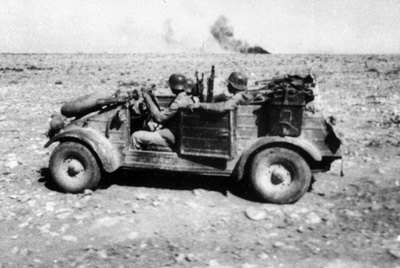 |
|
After ten days of heavy fighting, Rommel knew that the choices were to stay and get crushed by the relentless British attacks, or retreat—he ordered his army to prepare to make an organised withdrawal.
Hitler immediately intervened, ordering Rommel to ‘stand fast, yield not a yard of room and throw every gun and every man into the battle….victory or death!’.
Rommel knew the order was crazy. Defeat was certain, his army would be thrown away for nothing. For the first time Rommel began to doubt Hitler.
Another British attack smashed its way through the crumbling defences and Rommel, ignoring Hitler, ordered the remnants of the Afrikakorps to retreat west before they were overwhelmed.
|
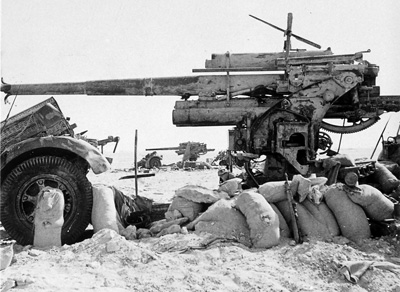 |
RETREAT TO TUNISIA
Pulling back from El Alamein, more bad news reached Rommel. A combined Anglo-American task force had landed in Morocco and Algeria far to his rear. Hitler was determined to hold onto North Africa and sent 10. Panzerdivision and Division General Göring to Tunisia under General von Arnim who promptly attacked with Operation Eilbote, halting the Allied advance just short of Tunis.
Meanwhile, after retreating more than a thousand miles, standing at Mersa El Brega and Buerat, the Afrikakorps made it to the Mareth Line on the border of Tunisia and Libya and dug in.
|
| The Eighth Army, supply lines stretched to breaking, could only follow up slowly. The Desert Fox took the initiative once more. |
KASSERINE PASS
The Afrikakorps now struck west against the American forces. While von Arnim attacked from the north with his Operation Frühlingswind, Rommel launched Operation Morgenluft taking Gafsa and threatening the vital Kasserine Pass. Just as in 1941 and early 1942, the veteran Afrikaners scattered their inexperienced opponents taking the pass in the follow-up Operation Sturmflut.
The Americans quickly recovered and ultimately it was Rommel who had to retreat. |
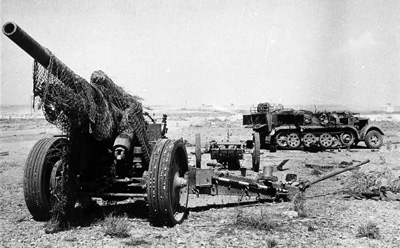 |
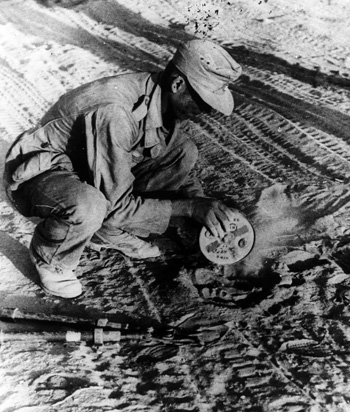 |
The Afrikakorps then turned and struck east, launching Operation Capri against the Eighth Army at Medenine. Once again Montgomery was ready and waiting and the attack was easily stopped. The Eighth Army then attacked the Mareth Line. The Afrikakorps inflicted heavy losses on the initial British attack, but outflanked, were forced to retreat. On 9 March 1943 Rommel, still not recovered from his earlier illness, departed from Africa, never to return.
The rugged Tunisian terrain was well suited for defence, but the combined US, British and French forces were overwhelmingly superior. Von Arnim made one last attack, the twin Operations Ochsenkopf and Ausladung.
Finally, on 12 May the proud Afrikakorps sent its last message: ‘Ammunition shot off. Arms and equipment destroyed. In accordance with orders received the Afrikakorps has fought itself into the condition where it can fight no more. The Afrikakorps must rise again. Heia Safari!’
|
RESURRECTION
Both 15. and 21. Panzer divisions were rebuilt to fight again. 15. Panzerdivision fought on in Sicily and Italy as 15. Panzergrenadierdivision, while 21. Panzerdivision met their old adversaries the Desert Rats again in Normandy, France after the D-Day landings in June 1944. |
Last Updated On Tuesday, January 11, 2022 by Wayne at Battlefront
|
|